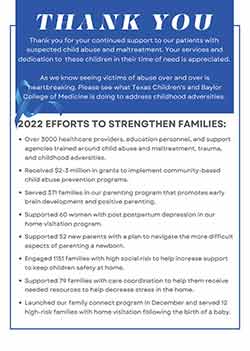
Last year, the child abuse pediatric team was consulted to see more than 200 admitted patients and over 500 patients in their outpatient clinic.
Providers who treat child abuse are particularly vulnerable to experience vicarious (or secondary) trauma, a process of change resulting from empathetic engagement with trauma survivors. This can lead to a range of negative physical and emotional symptoms like intrusive thoughts, flashbacks, anxiety, depression and burnout.
For Child Abuse Prevention Month in April, child abuse specialists from Texas Children’s spoke to other providers in a recent Respite Rounds conference on the unique challenges that come with treating difficult cases, and offered insights on protecting your mental health when caring for our most vulnerable children.
Navigating intense emotions and vicarious trauma
When asked to speak to her younger self, Dr. Marcy Donaruma said she’d offer up ways to better manage the intense emotions she felt. “I was always angry, and I learned that burning my fuel on anger wasn’t healthy,” she said. “You can be angry, but the time you take to sit in those feelings needs to be thoughtful, not sustained.”
Donaruma is a child protective health provider who spends most of her time seeing sexual abuse patients at the Children’s Assessment Center. “I always try to find ways to find the upside in rotten situations … even when it’s something major, you can always find an upside if you look hard enough,” she said.
Dr. Mackenzie Hughes, a clinical pediatric psychologist, shared her own perspective and tips on practicing self-care. “It’s OK to feel hopeless, especially when we’re hearing awful details and witnessing the horrors of child abuse every day,” said Hughes. “But when we stretch ourselves thin and spin our wheels trying to fix all the things, that’s when we start to burn out.”
“We each have a role to play,” Hughes continued. “I don’t have control over CPS or where the kids I work with are placed, but my role specifically is to help them process their traumas and give them what they need to heal and move forward.”
“My journey is my journey,” added Grace Harmon, a PICU social worker with 20 years of experience working with CPS and child abuse victims. “I’m here to support patients and families on their path, but I’m not doing them any benefit by taking it home with me … I can be present with them in the moment, but I had to learn how to say goodbye to the moment as well, for my own sake.”
Work-life balance is easier said than done, but incorporating small actions into your day that “wash off” the trauma you hear and interact with can make all the difference. Dr. Hughes suggests taking just five minutes to do a mindfulness activity, breathe, watch a funny video, or find something that activates your senses like taking the stairs.
Other tips and advice shared from the panel discussion include:
- Surround yourself with positive and hopeful reminders of why you do this work.
- It’s normal for the work to impact us … it doesn’t mean we’re not built for it or tough enough to handle it.
- Try to place focus on caring for and healing the child, not the circumstances that led them to us.
- Sometimes, the most patient-centered thing to do is let a child be surrounded by familiarity and biologic connection.
- When the effects of vicarious trauma start to impact your functioning, tap into professional support like therapy and treatment.
Click here to join the Respite Rounds Repository group on Teams and watch a full recording of the discussion, hosted by Palliative Care Service (PACT).
You are not alone
Need support? The Employee Assistance Program (EAP) is designed to promote emotional health and wellness, and improve quality of life at work and home. The program is confidential and here to support all Texas Children’s employees and eligible dependents with experienced, licensed and credentialed professionals. If you or someone you know is struggling, please contact EAP at 832-824-3327 or EAP@texaschildrens.org.
May is Mental Health Awareness Month, and our Workforce Well-Being team is hosting a variety of events, trainings, conversations, and more for Texas Children’s employees to take advantage of. Check the SharePoint site for a full list of activities!
The Child Abuse Protection team is available on-call to support staff and providers through possible maltreatment cases 24 hours, seven days a week. You can reach out via the page operator at 832-824-2099 or through an EPIC referral. For additional training surrounding child abuse, trauma-informed care and human trafficking, please contact Diane Kaulen at dbkaulen@texaschildrens.org.
Lastly, thank you to our Public Health Pediatrics and Child Abuse Protection teams for their continued dedication, research and advocacy. Click the flyer above for a recap of their efforts to address childhood adversities in 2022. With a team as great as ours, the difference is truly life-changing.






